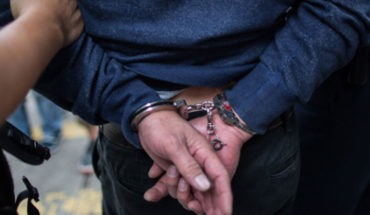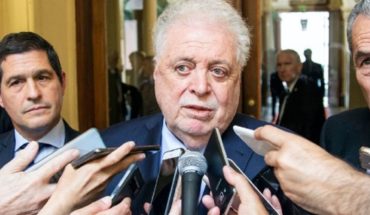The trip of Jose Mendoza, 37 years old, ended earlier than planned this Monday. He missed a few miles, but he didn’t get it. His plan was to sleep in his mother’s house, who has been living in Tapachula, Chiapas, for some time. Instead of enjoying a family reunion, Mendoza is locked up in the 21ST century migratory station, also in Tapachula. Next to him, his son, underage; Also his cousin and his wife, and his two nephews.
The Mendoza family is originally from Ocotepeque, a municipality in Honduras a few kilometres from the border with Guatemala. Being between two biological reserves has not spared the locality, of only 25.000 inhabitants, of suffering high rates of poverty, illiteracy and malnutrition.
None of the Mendoza has papers, so there are only two options left: asking for asylum, which is the only way to stay in Mexico, or be deported. If they ask for the shelter they may have to spend a lot of the process locked up. There are alternatives and the 21ST century is crowded, but the threat is real. If they do not ask that Mexico protect them they have only one way: the return to their country.
The six traveled in a combi that was intercepted in a migratory checkpoint installed next to the Mission Motel, at kilometer 6.5 of the Tapachula-Talisman Road. It is the only checkpoint that could be seen during the day of Monday, in the access from the borders of Talisman and Ciudad Hidalgo.
José Mendoza, in a green shirt, arrested with members of his family. Photo: Alberto Pradilla
In it, three agents of the National Institute of Migration (INM) with three vans of the institution, several federal police and a military truck with members of Navy, army and military police. The family is not the only one arrested. At least four other people remain inside one of the trucks, and two other young people will be intercepted during the next hour.
The arrest of Mendoza occurred after 8 a.m., just a few minutes since the chancellor, Marcelo Ebrard, spoke about the agreement signed on Friday between Mexico and the United States. The Mexican proposal is the sending of 6.000 troops of the National Guard to monitor the southern border, says Ebrard. But there’s no sign of the new body here. Not even some bracelets. And that last week, after the operation of Thursday against a caravan, the INM assured in a note that the new body had entered into action.
Mendoza doesn’t really care about the uniform. He’s been arrested by the usual agents, the Migrates, one of the great concerns for every migrant en route to the north.
Although in Tapachula and Ciudad Hidalgo there was only one catch, in other parts of Chiapas are operational. One of them was held in Arriaga, according to a video broadcast on social networks of the Mesoamerican migrant movement.
“We want to go to the United States, but first to Tapachula, because my mom told me to come, she had work for me,” says Mendoza, while she is driven to the van where she will remain at least an hour locked up. He’d like to go north, but he doesn’t have enough money. The transit with poultry from Honduras reaches 8.000 dollars, more than 150.000 pesos. He worked in a maquila and the salary barely reached him to survive. To borrow the guide to the United States.
Despite the hardships, he set off.
The man, of toasted skin and half-baked mustache, loads with his scarce belongings in a bag of green nylon. When the INM’s agents ask for his papers, he accepts his fate meekly. He doesn’t try to run or resist, he lets himself be carried away with parsimony, dragging his feet, looking at the ground. His relatives imitate him. They know they’re going to be locked up, but there’s not much room.
“We take them to the office,” one of the INM’s officials tells the wife of the cousin of Mendoza. Office is a euphemism for the migratory station, the largest institution in Latin America dedicated to locking up migrants who do not have the required documentation.
Migrants are not Arrested, if you don’t Insured or even Rescued. 21ST century is a Migratory Station, Not a Detention center. And, when they are returned to Honduras, Guatemala or El Salvador, they undergo a process of Assisted return, not a Deportation.
“It’s actually a deportation, but it looks like it’s going to be bad,” says one of the migratory agents, who doesn’t want to identify himself, like anyone else in this catch. In a burst of sincerity, he recognizes that, deep down, “a cage of gold is still a cage.” And Mendoza and their families will be locked up in Mexico’s largest migratory station. That is, the largest place in all of Latin America where people enclaustra to enter without documentation to a country that is not theirs.
“There, in Honduras, you can’t work. Now there are problems with strikes, “says Mendoza before being driven to the INM truck.
Since the end of May, organizations of doctors and professors paralyze the activity in the Central American country. They protest what they consider to be a plan for the privatization of these services by the Government of Juan Orlando Hernández. Honduras underwent strong polarization since 2009, when a coup d’état ousted the then president, José Manuel Zelaya. The November 2017 elections, in which Hernandez was re-elected, were closed with allegations of fraud and protest in which more than 30 deaths were recorded.
No official data on deployment
The southern border is at the heart of the media focus since the beginning of the negotiations between Mexico and the United States. In the end, two agreements for Washington not to impose 5% tariffs on Mexican products, at least in the next 45 days: The Mexican government will reinforce the control of its borders with Guatemala and Belize, and will accept asylum seekers in the United States As long as a judge solves your case.
In the south, for the moment, there is no trace of the National Guard. However, the police presence has been reinforced, especially after the blockade last week of a caravan of about 400 people who entered the country, through the river. At least, that’s what the government says.
The rhetoric, however, does not find its reflection in the figures. Political Animal tried to know what was the deployment of agents of various bodies destined for migratory control. A source of the Ministry of the Interior said that last week 400 federal police were sent, who joined the contingent already deployed in the southern state. This week, another 100 Federal protection troops went to the 21ST century migratory station, which has recorded several riots and escape attempts throughout the year. These federal cops are going to be part of the National Guard when they pass the briefing.
What we know is that in the checkpoints there are agents of the INM, Federal police, military police, navy and army. But not INM, neither the secretariat of the Interior (SEGOB), nor the secretariat of the National Defense (Seder), neither Navy nor Chancellery (which was the one in charge of negotiating with the United States) provide data on how many agents are on the ground, where, if they will come to form Part of the National Guard or there will be new moves. Nobody says anything and they all make sure they don’t have data.
On the 6.000 agents promised, a source in public security said that “there are already between Marina, Seder, Federal Police and migration”, although it is envisaged that “gradually” new troops will be deployed. They would not arrive until June 30, when the first enrolled in the training course to enter the body are graduated.
Barracks are planned to be built in Tonalá, Pichucalco and Palenque, according to the government of Chiapas. Meanwhile, there are troops barracks in Puerto Madero.
More Cubans than Central American
On the bank of the river, natural border between Mexico and Guatemala, absolute tranquility before the storm that puts an end to the water transit after 4 in the afternoon. “You see a lot less people and those who come are Cubans,” says Juan Carlos Arana, a huge hombretón who has been working in this blind spot for 20 years. Over here it passes merchandise that does not pay taxes and migrants that do not charge visa. This has always been the case and we will have to see to what extent it will be when the plan agreed with the United States is implemented.
“Central Americans are very few,” says Arana, who spends his day, from six in the morning to six in the afternoon, watching these gondolas of Tyre and wood cross.
It estimates that, every day, about 20 migrants from Honduras (majority), Guatemala and El Salvador, would cross. Chapins, which is known as Guatemalans, do cross, but by the natural relationship between Tecún Umán and Ciudad Hidalgo. They did arrive before, he says, and he remembers the caravans that began in October 2018. The exception: Last week’s group attempt. These, however, crossed through the bridge Rodolfo Robles without police resistance.
While Arana speaks, two groups of migrants arrive aboard the rafts. They are distinguished miles by their bulging backpack and their gesture of concern. They have a face of not trusting anyone and they do well. All of them are Cubans. They’re all young men, except a woman on the second team. No one wants to talk. They walk with a martial gesture, without looking back. They come out quickly looking for a way to get to Tapachula. On the way they will have to circumvent the catch of the INM. The first in a long list of police checks.
Irregular migration forces clandestinely, to walk in hiding. That’s why too much noise is damaging. If you add the promise of the government of Andrés Manuel Lopez Obrador that will multiply the PREssence of uniformed, it seems logical that migrants are looking for alternative routes. These roads are more dangerous, according to Heyman Vázquez, pastor of Huixtla, in Chiapas, another municipality on the route to the north.
In a conference that claimed the freedom of Irineo Mujica and Cristóbal Sánchez, activists detained on 5 June and on Tuesday face an audience, the religious warned that migrants arriving in Huixtla do so in worse physical conditions. He said that the assaults on the route have increased. He said, for example, that a group that arrived on Sunday related an attack in which the women were stripped and snatched all their belongings.
Coparmex sees opportunities and applauds agreement with Washington
The announcement of the arrival of the National Guard was received with satisfaction by José Antonio Toriello, president of Coparmex coast of Chiapas. The employer said to celebrate the agreement between Mexico and the United States because, at the moment, it puts an end to the threat of tariffs and, on the other, because the increase of troops of the National Guard will allow “better control” the arrival of migrants.
“It benefits us because there is immigration restraint, because there is more security with the presence of the National Guard alone,” he said. A concept that repeated on several occasions: “Containment through development”. A proposal that connects with the plans launched by López Obrador so that the Central American migrants will remain working in the southern states.
Toriello applauded what he considered to be a change in the position of López Obrador, who in his opinion has moved from the “open Doors” to a “greater control”.
Apart from public statements that control is done by the usual methods: INM checkpoints that review all the combis and taxis to lock the Central Americans without documents that just stepped on Mexico.
Thank you for reading! Help us get on with our work. How? Now you can subscribe to the political Animal on Facebook. With your monthly donation you will receive special content. Find out how to subscribe here. Check out our list of frequently asked questions here.
translated from Spanish: The National Guard, even without deployment in Chiapas
June 11, 2019 |





